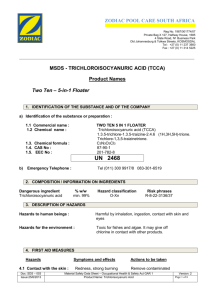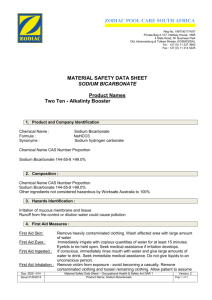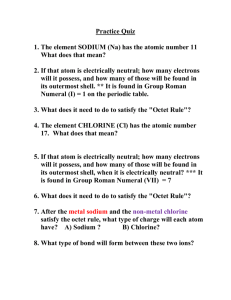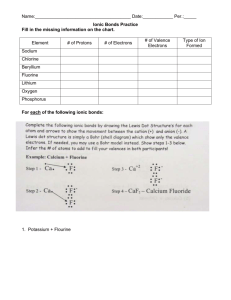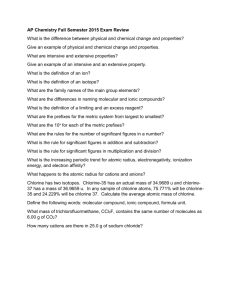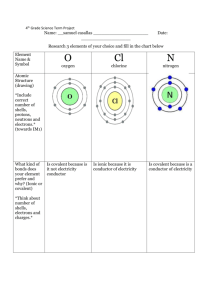MSDS - Zodiac
advertisement
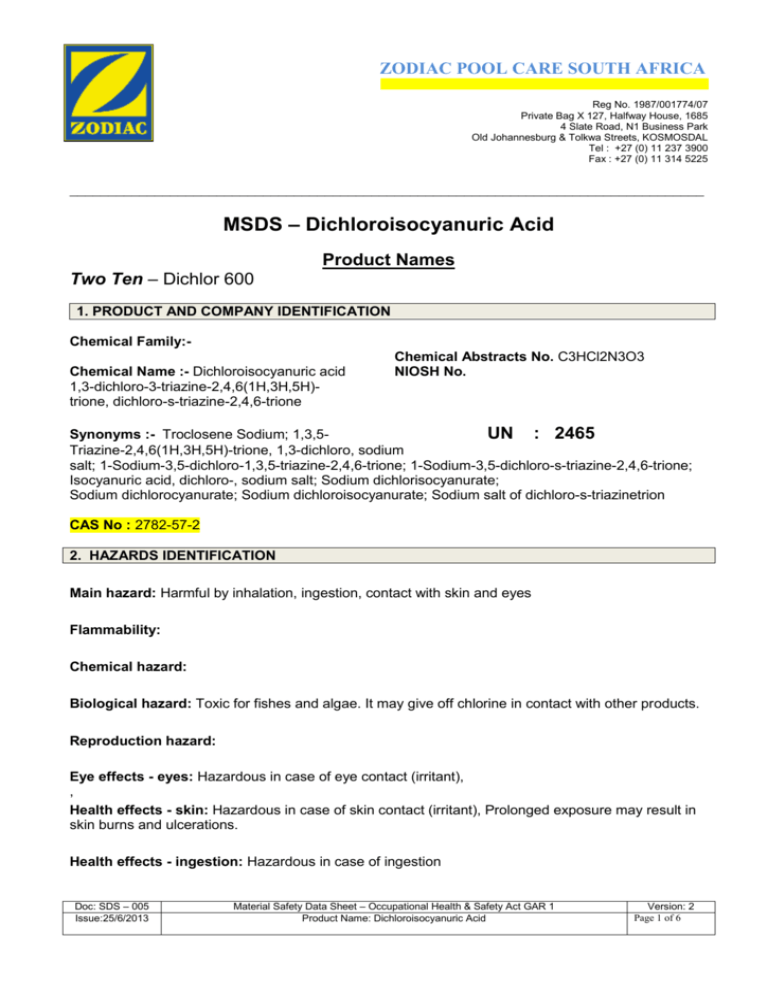
ZODIAC POOL CARE SOUTH AFRICA Reg No. 1987/001774/07 Private Bag X 127, Halfway House, 1685 4 Slate Road, N1 Business Park Old Johannesburg & Tolkwa Streets, KOSMOSDAL Tel : +27 (0) 11 237 3900 Fax : +27 (0) 11 314 5225 __________________________________________________________________________________ MSDS – Dichloroisocyanuric Acid Product Names Two Ten – Dichlor 600 1. PRODUCT AND COMPANY IDENTIFICATION Chemical Family:Chemical Name :- Dichloroisocyanuric acid 1,3-dichloro-3-triazine-2,4,6(1H,3H,5H)trione, dichloro-s-triazine-2,4,6-trione Chemical Abstracts No. C3HCl2N3O3 NIOSH No. Synonyms :- Troclosene Sodium; 1,3,5UN : 2465 Triazine-2,4,6(1H,3H,5H)-trione, 1,3-dichloro, sodium salt; 1-Sodium-3,5-dichloro-1,3,5-triazine-2,4,6-trione; 1-Sodium-3,5-dichloro-s-triazine-2,4,6-trione; Isocyanuric acid, dichloro-, sodium salt; Sodium dichlorisocyanurate; Sodium dichlorocyanurate; Sodium dichloroisocyanurate; Sodium salt of dichloro-s-triazinetrion CAS No : 2782-57-2 2. HAZARDS IDENTIFICATION Main hazard: Harmful by inhalation, ingestion, contact with skin and eyes Flammability: Chemical hazard: Biological hazard: Toxic for fishes and algae. It may give off chlorine in contact with other products. Reproduction hazard: Eye effects - eyes: Hazardous in case of eye contact (irritant), , Health effects - skin: Hazardous in case of skin contact (irritant), Prolonged exposure may result in skin burns and ulcerations. Health effects - ingestion: Hazardous in case of ingestion Doc: SDS – 005 Issue:25/6/2013 Material Safety Data Sheet – Occupational Health & Safety Act GAR 1 Product Name: Dichloroisocyanuric Acid Version: 2 Page 1 of 6 Health effects - inhalation: Hazardous in case of inhalation (lung irritant). Over-exposure by inhalation may cause respiratory complications. Carcinogenicity: Not available Mutagenicity: Not available Neurotoxicity: Repeated or prolonged exposure is not known to aggravate medical condition. 3. COMPOSITION / INFORMATION ON INGREDIENTS Name Dichloroisocyanuric Acid Sodium Salt R Phrases R-8EEC Classification :- CAS # 2893-78-9 % by Weight 100 22-3136/37 4. FIRST AID MEASURES Product in eyes : Pain and tears. Impaired Flush with plenty of vision. water. Call a doctor. Product on skin : Redness, strong burning Remove contaminated sensation, with eventual clothes. Flush skin with ulceration. plenty of water. If irritation persists, call a doctor. Product Ingested: - Abdominal pain, nausea, If patient is conscious general weakness. drink milk, white of egg or water. Call a doctor. Do not provoke vomiting Product Inhaled:- Sore throat, cough, nausea. Take patient to fresh air, rest and if necessary call a doctor. 5. FIRE FIGHTING MEASURES Extinguishing media : Water CO2 Extinguishing media not to be used : Powder based on ammonium salt and halogenous extinguishing media. Special hazards Extinguish with big quantities of water (small quantities may aggravate the situation). Product is not flammable, but may decompose at high temperatures, thus emitting toxic gases. If the fire only affects part of the drums, isolate them from the rest by taking them if possible to a well ventilated area and letting them consume. For small fires CO2 extinguishers can be used. Special protective clothing Self-contained breathing equipment to protect the respiratory tracts, as well as clothes and gloves suitable for skin protection. 6. ACCIDENTAL RELEASE MEASURES Personal precautions : Full mask equipped with suitable filter (combined for dust and halogens). Gloves, i.e. of polyethylene. Suitable working clothes fully protecting the body. Goggles or eye shield. Doc: SDS – 005 Issue:25/6/2013 Material Safety Data Sheet – Occupational Health & Safety Act GAR 1 Product Name: Dichloroisocyanuric Acid Version: 2 Page 2 of 6 Environmental precautions : Prevent product from reaching the sewage system or superficial water. If product reaches a natural water-course, warn the civil protection authorities. Spills : Sweep and fully collect the spilled product. If there is some non-polluted product left separate it from the rest and collect it into the original drum or another clean container with inner plastic bag; this product can normally be used. Dirty product must be collected from the ground into the original drum or another clean container with inner plastic bag and must be destroyed. Product contaminated with water or other chemical products must not be transported. It must be immediately diluted with plenty of water and destroyed. 7. HANDLING AND STORAGE Suitable material:- Separate from acids, alkalies, reducing agents and combustibles. Handling & Storage : Do not produce dust. Handle far from other chemicals. Do not smoke. Keep product in suitable closed containers (metallic or wooden containers must not be used), in a fresh, dry and ventilated place, far from any ignition source and other chemical products. If product is stored with other products, it should be placed in a separate compartment near the exit door, which should be free from obstacles, in order to take product away quickly if necessary. 8. EXPOSURE CONTROLS / PERSONAL PROTECTION Occupational Exposure Limits: Ingredient TVL TWA TLV STEL Dichloroisocyanuric acid 1.5 mg /m = 0.5 ppm 3 mg/m = For chlorine gas 1 ppm for Chlorine gas Engineering Controls: Use process enclosures, local exhaust ventilation, or other engineering controls to keep airborne levels below recommended exposure limits. If user operations generate dust, fume or mist, use ventilation to keep exposure to airborne contaminants below the exposure limit. Personal Protection Respiratory Dust respirator Be sure to use an approved/certified respirator or equivalent Personal Protection- hand :- Gloves Personal Protection-eye:- Splash goggles Personal Protection-skin:- Suitable working clothes fully protecting the body. Other - Monitoring procedures : Drager, etc. 9. PHYSICAL AND CHEMICAL PROPERTIES Appearance: White powder (90) or granules (GR90) Odour: Slight chlorine odour PH: (1% solution) : 2.7 – 3.3 Boiling point: N/A Doc: SDS – 005 Issue:25/6/2013 Material Safety Data Sheet – Occupational Health & Safety Act GAR 1 Product Name: Dichloroisocyanuric Acid Version: 2 Page 3 of 6 Melting point: 225°C with decomposition Flash point: Over 250°C (ASTM-D-92) Flammability: Non flammable Auto flammability: N.A. Explosive properties: Oxidizing properties: Vapour pressure: N.A. Bulk Density : Approx. 1,000 kg/m Solubility - water: at 25°C : 12 g/litre Solubility - solvent: Partially soluble in acetone. Solubility in acetone: 0.5 g/100 g acetone @ 30 °C Solubility - coefficient: N.D. n-octanol / water : Neurotoxicity: 10. STABILITY AND REACTIVITY 10.1 Stability : Product is stable in normal storage conditions. Product loses less than 1% chlorine after one year at 10.2 Conditions to avoid : 10.3 Materials to avoid : Product attacks metal in general. It reacts with water (in small quantities which may moisten product, but great quantities of water are necessary to extinguish a fire), oxidant and reducing agents, acids, alkalis, nitrogen products, ammonium salts, urea, amines, quaternary ammonium derivatives, oils, fats, peroxides, catoinic tensioactives, etc. 10.4 Hazardous decomposition products : In combination with the above mentioned products, it decomposes and gives off a great quantity of heat, chlorine, nitrogen trichloride, etc. with subsequent danger of explosion if nitrogen trichloride level is high enough. 11. TOXICOLOGICAL INFORMATION 11.1 Acute LD50 oral rat : 406 mg / kg 11.2 LDL oral human : 3,570 mg / kg 11.3 Acute LD50 dermal rabbit : 20 g / kg 11.4 Sensitization : N.D. 11.5 Carcinogenicity : N.D. 11.6 Mutagenicity : N.D. 11.7 Reproductive toxicity : N.D. Toxicological Data on Ingredients: Dichloroisocyanuric Acid Sodium Salt: ORAL (LD50): Acute: 1420 mg/kg [Rat]. 12. ECOLOGICAL INFORMATION 12.1 General information on substance behaviour in the environment : Toxic for fish and algae. Do not pour directly into rivers lakes, etc. Product hydrolises in diluted aqueous solution giving off hypochlorus and cyanuric acids.The first one is transformed into chloride with time and the action of the sunrays. The second one is biodegradable and practically non toxic. Therefore, the diluted solution can be directly poured to the sewer system, depending on the applicable local regulations, provided the chlorine content is of 0 ppm. 12.2 Mobility : N.D. 12.3 Persistance and degradability : N.D. 12.4 Bioaccumulation potential : N.D. 12.5 Aquatic toxicity : N.D. Doc: SDS – 005 Issue:25/6/2013 Material Safety Data Sheet – Occupational Health & Safety Act GAR 1 Product Name: Dichloroisocyanuric Acid Version: 2 Page 4 of 6 12.6 COT theoretical : 0.15 g C / g 13. DISPOSAL CONSIDERATIONS 13.1 Disposal of material : Proceed as follows : add 2.5 kg of sodium carbonate to 20 litres of water, stir and dissolve. Slowly (in about 0.5 hours) add 1 kg of product. Let stand for at least 10 hours. Slowly add (in about 0.5 hours) while stirring 0.5 kg of sodium sulphite. Then check if there is some free-chlorine left. If necessary add more sodium sulphite until chlorine value is 0. Neutralise if necessary. The above operations should be carried out in the open air wearing suitable equipment (i.e. full mask with halogen filter and goggles), as chlorine gas may be feed off. The container and stirring rod should be of corrosion-resistant materials (i.e. plastic, etc.) 13.2 Disposal of packaging : Used packagings can be disposed of at an authorised dump. 13.3 Disposal of waste : The waste obtained as mentioned in paragraph 13.1 diluted in a great quantity of water can be poured to the sewer, according to the local regulations, as it only contains a mixture of salts and cyanuric acid which is biodegradable. Another disposal method for dry product is by incineration mixing product with solvents. The incinerator should be provided with a washing system for chlorine combustion gases. Disposal of product should be carried out according to local or national regulations on industrial waste disposal. 14. TRANSPORT INFORMATION 14.1 Labelling for transportation : Oxidising agent 5.1 (black bomb on yellow background). 14.2 Substance for identification : 50-2468 14.3 ADR / RID ; 5.1, 26 b 14.4 IMDG : 5.1 / ll UN 2468 14.5 ICAO / IATA 5.1 UN 2468 15. REGULATORY INFORMATION 15.1 EEC No : 201-782-8 15.2 Hazard Symbol : O : Oxidising Xn : Harmful 15.3 R and S phrases : R 8 Contact with combustible materials may cause fire. R22 Harmful if swallowed. R31 Contact with acids liberates toxic gas. R36/37 Irritating to eyes and respiratory system. S 2 Keep out of reach of children. S 8 Keep container dry. S 26 In case of contact with eyes rinse immediately with plenty of water and seek medical advice. S 41 In case of fire and / or explosion, do not breathe fumes. S 46 If swallowed, seek medical advice immediately and show this container or label. WARNING ; DO NOT USE TOGETHER WITH OTHER PRODUCTS. MAY RELEASE DANGEROUS GASES 16. ANY OTHER RELEVANT INFORMATION ; The above information is also provided with regard to law 31 / 1995 of the 8 November B.O.E.10-11-95 and the E.U. Directive 89/391 on labour risks. N.A. = non applicable N.D. = non defined Doc: SDS – 005 Issue:25/6/2013 Material Safety Data Sheet – Occupational Health & Safety Act GAR 1 Product Name: Dichloroisocyanuric Acid Version: 2 Page 5 of 6 DISCLAIMER Zodiac Pool Care SA (Pty) Limited believes that this information is correct at date of publication but does not warrant the accuracy thereof. The use of the product designated herein will be at the sole risk of the user and Zodiac Pool Care SA (Pty) Limited will not accept any liability for any loss or damage, including consequential loss, howsoever caused by or arising from the use of this information of the use, application, adaption or processing of the product described herein or its use in combination with any other product, material or in any process. Date of General Update- 20 June 2014 Doc: SDS – 005 Issue:25/6/2013 Material Safety Data Sheet – Occupational Health & Safety Act GAR 1 Product Name: Dichloroisocyanuric Acid Version: 2 Page 6 of 6

